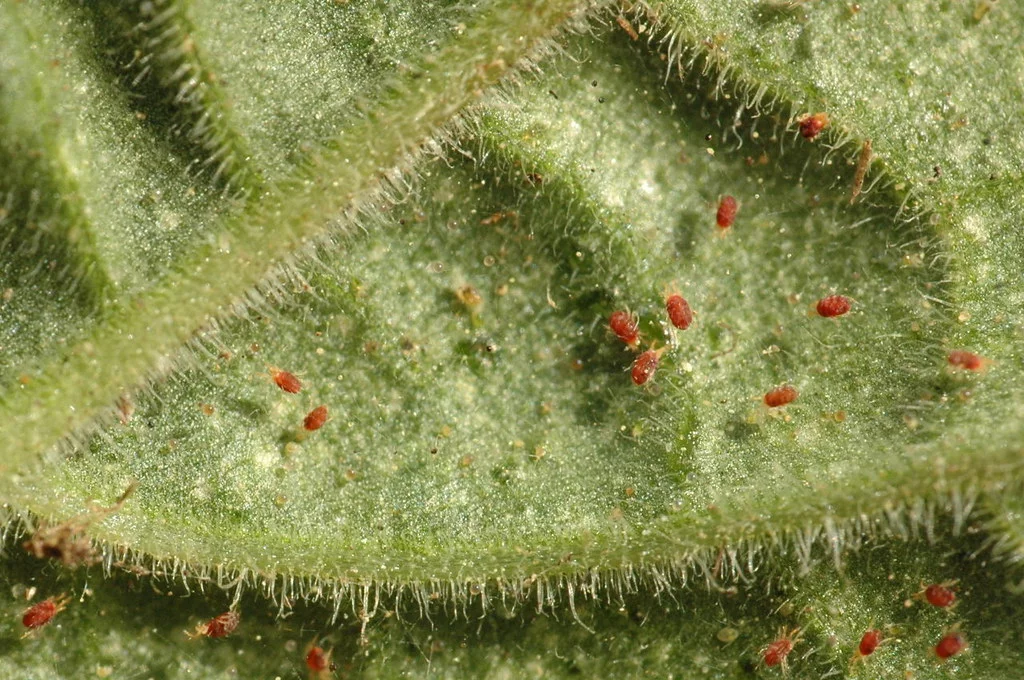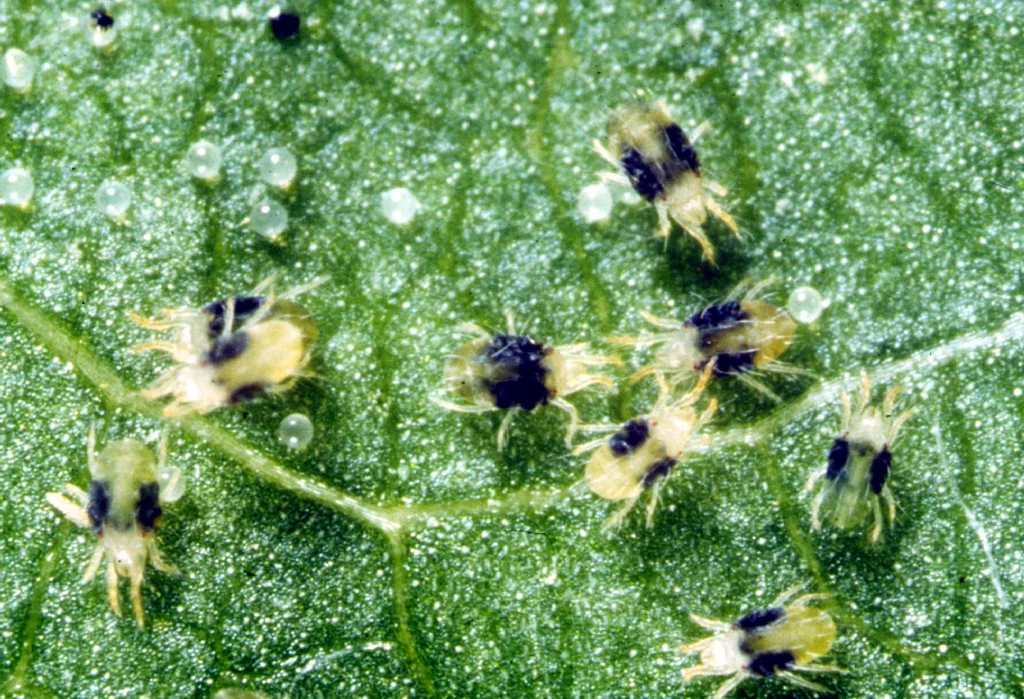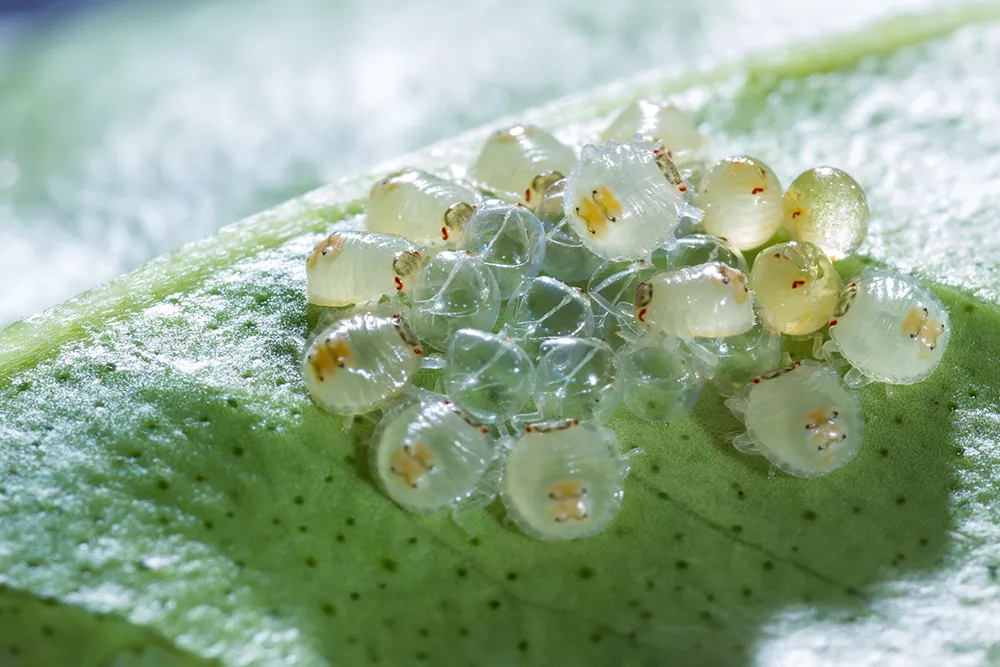If you hate spiders, you better brace yourself. Because today we’re talking about the only thing worse than spiders: spider mites. They may be small and able to go undetected for a while, but once these garden or houseplants pests begin to infest your plants, you’ll know that you have a spider mites problem pretty quickly. Unlike normal spiders that at least get some credit for pest control in and around your home by eating insects like house flies and mosquitoes, spider mites suck the life out of your plants. They ruin all of your hard work in the garden, and leave you looking for the best spider mite killer that you can find.
If you’re in this situation (and most of us with plants will be in this situation at some point), we’ve got you covered. We’ve rounded up the best natural and organic methods to fight a spider mite infestation, to keep your plants healthy for a successful growing season.
Spider Mites

What Are They?
Spider mites are in fact more like spiders than other pest insects. They are part of the arachnid family. Spider mites are common to areas with hot, dry weather conditions in the summer. They live in colonies, typically on the backside of plant leaves. Plants in areas with dusty conditions and stress from limited water are highly susceptible to spider might invasions.
Spider mites can survive during the winter season on the leaves or bark of their host plant in their egg stage. In the spring, the mites’ eggs hatch into larvae and grow into nymphs and then finally adults. Depending on the climate, spider mites can progress from eggs to mature adults in as little as a week.
Adult spider mites will lay eggs continuously after mating, and can lay up to 300 eggs over a couple week period. So, it’s really important when fighting a spider mite infestation to not only kill the adults, but all stages of spider mites, including the eggs. And to continue frequently applying products to kill any newly hatched pests.
There are several different spider mites species that fall under the broader term of spider mites, or webspinning mites as they’re also called. Common species include two-spotted spider mites, red spider mites, and Pacific spider mites.
What Do Spider Mites Look Like?

They vary in color, but spider mites are usually a yellow or reddish brown in color, and very small. They are smaller than the head of a pin, about 1/50th of an inch, almost too small to see. You might need a magnifying glass to get a good look at them.
Spider mites are wingless insects, and like spiders or ticks, which also belong to the arachnid family, adult mites have eight legs. Depending on the species of spider mites, they may also have spots, like the common two-spotted spider mite.
Spider mites eggs are clear and round. They look almost like small water droplets on the underside of leaves.
Large spider mites populations usually include a fine webbing on the host plants. Like you might picture with any other type of spider, spider mites also create webs, giving them their name. Other than the visible damage to your plants, the webs that they spin are the best indicator that you have a spider mite infestation in your garden.
What Do They Do to Plants?
Spider mites feed off of your plants. They bite into the leaves and suck out the fluids from the plant tissue. If you catch a mite infestation early, you might notice stippling. You’ll see small dots of lighter color on the leaves of your plants.
But as the colony continues to grow and feed, they will turn your leaves completely yellow. The leaves might even dry up and fall off entirely from the loss of fluids. Even if you’re successful in containing the spread of the infestation, and killing the pests, there’s nothing you can do about the damage that they’ve already created.
Losing leaves can have a significant impact on the host plant. Without healthy leaves, photosynthesis is limited and your plants will suffer. Your garden may experience lower yields and your plants will not be able to grow to their full potential. Spider mites can also attack the produce of certain crops directly, like the pods of beans and sugar peas.
What Plants Do They Affect?
Spider mites can attack indoor plants and outdoor plants. Mite infestations can be particularly bad in greenhouse growing environments. They tend to thrive in conditions where their natural predators, the beneficial insects that eat them, have been killed off by the use of insecticides.
Hundreds of different plants can be affected by spider mites infestations, including strawberries, tomatoes, and melons. Spider mites will also feed on ornamental flowers like roses, and on trees and shrubs. There are many species of spider mites that can affect both your houseplants or the plants in your garden.
Spider mites can spread to neighboring plants by the wind. Their tightly woven webs are carried off in the wind, and can infest plants far away from the previous host plants. That’s why it’s key to remove any plants with signs of spider mite damage, even if they’re clear on the other side of your yard from the rest of the garden.
How Can you Get Rid of Spider Mites?
Use an Organic Insecticide
If you’re looking for an effective product to kill spider mites, Grower’s Ally Spider Mite Control is a great option. It kills and repels soft-bodied insects around the application area, including adult and nymph spider mites.
We recommend this product as one of the best spider mites killers, not only because it’s proven to work, but because it is OMRI listed. Grower’s Ally provides an option for certified organic growers, or any grower looking for a natural alternative to chemical pesticides. This organic pesticide has been reviewed by the Organic Materials Review Institute, an independent organization trusted for its clear guidelines on acceptable materials for organic operations.
The Spider Mite Control product is an insecticide, miticide and repellent, so it works overtime in your garden, helping to keep your plants healthy. It tests clean, and the active ingredients are natural oils that you can feel good about using on your crops (rosemary, clove and peppermint oils).
It paralyzes pests like spider mites by overstimulating and disrupting their nervous system. It also suffocates them on contact. Grower’s Ally Spider Mite Control can be used as a repellent too. Any insects not in direct contact from spraying will be encouraged to find a new home thanks to the natural repellent properties of the rosemary oil in this blend.
This product is sprayed generously on to the stems and leaves of your plants. It can be used for both indoor and outdoor plants, as well as greenhouses and hydroponic growing operations. If you’re using it for preventive care, it should be applied every 10 days, and if you’re actively trying to fight an infestation, apply every 5 days and begin as soon as you see signs of spider mites.
Frequent and repeated applications of the product are very important when trying to kill a spider mite colony because eggs will continue to hatch even after the adults have been killed. To really control spider mites infestations, you need to make sure that pests in all stages of the lifecycle are eliminated from your plants.
Other Natural Alternatives

Remove Infested Plants
When your garden has an outbreak of spider mites, the first thing that you should do, if possible, is to remove all affected plants. Infestations spread quickly, so you need to act fast. Remove the entire plant if you can, but at a minimum prune back leaves and stems that have visible signs of webbing and spider mite damage.
Get rid of these parts of the host plant as soon as you notice the pests, and throw away the clippings in the garbage. You never want to compost infested plant material, because you risk spreading the spider mites to more of your garden.
Add Beneficial Insects
There are certain insects, like predatory mites, that prey on spider mites and naturally control their spread. Heavy use of chemical insecticides can actually kill off these predators and create an ideal environment for spider mite colonies to take over.
Although you might think that all mites are bad for your plants, predatory mites actually feed on the eggs, larva, and mature adults of the mite species that eat your plants. Rather than sucking the life out of your plants, these mites help limit the growth of spider mite colonies, and support the health of your garden.
You can purchase some insects like predatory mites and lady bugs that are natural enemies of spider mites, to add them to your garden as a natural line of defense against spider mites. Many people also find a large population of the good insects that they need and relocate some of them to feed on their pest insects.
It’s critical to diagnose the pest issue in your garden before you start adding other insects to the mix. Predatory mites can resort to feeding on your plants if there isn’t enough prey to sustain them. The last thing you want to do is introduce another pest to your garden that will damage your plants.
Use Insecticidal Soap or Neem Oil
You can also try to control spider mites by spraying insecticidal soaps or horticultural oils on your plants. Both are good natural alternatives for pest management, especially when it comes to fighting off spider mites.
Neem oil is made from the fruits and seeds of the neem tree. It is a natural, organic pesticide that has also been used in many safe consumer products for years. It’s safe to use around animals, and it kills pests at all stages of the lifecycle, from eggs to adult spider mites.
Insecticidal soap is another natural option that can be sprayed to cover plant foliage as a spider mites killer. Soaps disrupt the insect or mite cell membranes, killing the pest by causing them to dehydrate. Insecticidal soaps can kill predatory mites as well though, so avoid applying them if you know that you have these natural enemies already taking care of your spider might problem.
Both horticultural oils and insecticidal soaps need to contact the pests in order to kill them. So, make sure to spray them generously and get good coverage of all susceptible areas of the plants (including those coveted undersides of the leaves).
Conclusion
The best thing that you can do for your plants to avoid a major spider mite infestation is to monitor their health regularly. Mites are very small, so it’s unlikely that you’ll see them directly, but check for signs of stippling and other damage to your plants, like yellowing leaves. And keep an eye out for fine webbing on leaves and stems, since this is a clear indication of a spider mite colony.
Avoid dusty conditions in your garden or indoor growing environment. Make sure to irrigate or water your plants sufficiently to avoid water stress, which can make it hard for your plants to withstand the damage from pests.
Spider mites can attack many different types of plants, and they don’t discriminate between indoor and outdoor environments. You can experience these garden invaders in your household plants and greenhouses as well, so be vigilant wherever you are growing plants.
Once you’ve spotted signs of spider mites infestations on your plants, act quickly because they can spread and multiply just as fast. Remove infested leaves, and if available, you can add insects that act as natural spider mites predators. The best spider mites killers come in the form of sprays that can be applied to your plants. Apply sprays like insecticides, soaps, and oils frequently with good coverage to ensure that spider mites populations are contained, killed, and prevented from affecting your next growing season.
Thank you